LOST VEGAS: The Railroad Cottages
Posted on: August 5, 2025, 07:21h.
Last updated on: August 5, 2025, 03:08h.
- Las Vegas was originally settled by railroad workers and laborers who needed places to live
- Between 1909 and 1911, Salt Lake (now Union Pacific) railroad built 64 cottages to house its workers
- Of the 28 cottages remaining in 1978, only one is still standing where it was built today
Before it was a gambling town, before its first dam worker, Las Vegas was a railroad town.

Its first major influx of settlers came to work as laborers, mechanics, and clerks for the San Pedro, Los Angeles, and Salt Lake (later Union Pacific) Railroad. Spearheaded by Senator William Andrews Clark, for whom the southern portion of Lincoln County would later be renamed, this rail line arrived in 1905 and begat the land auction that established Las Vegas.
To house this group of laborers — mostly white and male American citizens and Mexican immigrants, with a smaller number of Chinese and European workers — the railroad built 64 cottages between 1909-11. The total cost was around $110K ($3.65 million today).
The two- and three-bedroom cottages were constructed on former ranch land along Second, Third, and Fourth streets. (Second is today’s Casino Center Boulevard.) Since lumber was difficult to come by in the desert, they were fashioned of half-size cinder blocks, created on-site with local sand.
Previously, railroad workers had lived in tent houses downtown.
Better Late Than Never

The historicity of the railroad cottages wasn’t acknowledged until 28 of them were identified as still standing by a 1978 city of Las Vegas survey called the Historic Preservation Inventory & Planning Guidelines.
By the time the Railroad Cottage Historic District was listed with the National Register of Historic Places in 1987, only eight made it to the list.
The others were either demolished, damaged, or altered in a way that diminished their historical significance. (A few may have been too distant from the others to be considered as part of one single district.)
Seven of those eight cottages were later demolished or relocated to make way for a 60-story condo tower called Club Renaissance.
Four were moved to the Springs Preserve museum in 2005 and 2006, where they were opened to the public in 2017. Another was relocated to the Clark County Museum in Henderson around the same time.
Why Weren’t They Protected?
Historical designation doesn’t guarantee protection against demolition, alteration, or relocation — especially for privately owned properties. It provides recognition and potential tax incentives for preservation, but doesn’t restrict private owners from modifying, demolishing, or moving structures unless federal or state involvement triggers review under Section 106 of the National Historic Preservation Act.

Las Vegas didn’t establish local historic district protections for these cottages, leaving them vulnerable to development pressures.
The lone remaining cottage, at 629 S. Casino Center Blvd., today houses an insurance and bail service. Owned by the Joseph and Verla Dawson Family Trust, it survives only because it wasn’t in the direct path of Club Renaissance.
Other than the Old Mormon Fort, built in 1855 on what’s now Washington Avenue, it is believed to be the oldest house in Las Vegas still standing where it was constructed.
Oh yeah, and Club Renaissance was never even built.
“Lost Vegas” is an occasional Casino.org series spotlighting Las Vegas’ forgotten history. Click here to read other entries in the series. Think you know a good Vegas story lost to history? Email corey@casino.org.
Last Comment ( 1 )
608 S 3rd Street is also an original railroad cottage that is still in place.